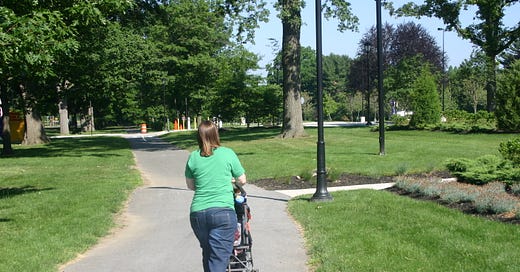Growing up one of my favorite movies was “Baby Boom” with Diane Keaton, the story about a strong, independent businesswoman with the world at her feet, whose life takes a sudden turn when she inherits an orphaned baby from a distant cousin. This unexpected responsibility challenges her meticulously planned life and forces her to reconsider her priorities and, ultimately, find a new sense of fulfillment.
There is one particular scene where she’s pushing the baby stroller, trying to keep up with another businesswoman who is briskly walking down the sidewalk. She soon realizes she can't keep up; she's no longer living the version of who she used to be, but rather accepting and embracing her present version.
No matter how many times I have seen this movie, I always stop and pay attention to that scene. For me the scene beautifully encapsulates the essence of Mindfulness—accepting things as they are so that we can be fully present and remove ourselves from the ruts of being stuck in the past or preoccupied with the future.
I have struggled so much with being able to be present in my life, especially after big life milestones when the reality didn’t quite match up to the expectations I had created in my mind. I was perpetually stuck in the feeling that This isn’t the Life I Thought I Wanted.
It might not have been the life I thought I wanted, but it was definitely the life I was unconsciously creating through constantly looking to the past for regret or to the future for worry. Avoiding being present was easy as I was notorious for keeping myself busy with distractions.
Easily blaming but voluntarily succumbing to the constant pressures of work, social obligations, and personal goals that created a whirlwind of activity that left me feeling like I was merely going through the motions of life. This relentless busyness prevented me from being fully present, reflecting on my life, expressing gratitude for all the good I did have in my life, or consciously creating the life I really wanted.
From Constant Distraction to Mindful Presence
To move from this state of constant distraction to practicing mindful presence, I needed to intentionally incorporate mindful practices into my life. By embracing mindfulness techniques including bringing awareness to my breathing and emotions and learning how to let go of control, over time I was able to create a shift that enabled me to actively live and consciously participate in my life, rather than just passively moving through it with distraction.
If you feel it challenging to be fully present or feel that you are going through the motions of life, set some time aside daily (5-10 minutes to start) to implement the following mindfulness strategies.
Breathing Awareness
One of the foundational practices of mindfulness is breathing awareness. By focusing on our breath, we anchor ourselves in the current moment, reducing stress and anxiety. This simple yet powerful technique helps us detach from racing thoughts and overwhelming emotions, fostering a sense of calm and clarity. Practicing mindful breathing allows us to pause and accept where we are, enabling us to respond to situations with greater composure.
Emotional Awareness
Emotional awareness is another critical aspect of mindfulness. By tuning into our feelings without judgment, we gain insight into our emotional landscape, which can improve our mental and emotional well-being. This practice encourages us to acknowledge and process our emotions, rather than suppress them. Life’s challenges can initially have us perceive situations as obstacles, but through emotional awareness, we can begin to see the joy and fulfillment that change can bring into our lives and being mindful of our emotions helps us navigate life's challenges with empathy and understanding.
Letting Go of Control
Letting go of control is perhaps the most transformative benefit of mindfulness. By releasing the need to control every aspect of our lives, we open ourselves up to new possibilities and experiences. When life throws us a curveball, mindfulness helps us to learn to let go of rigid expectations and embrace the unexpected joy that results from not grasping to expectation of outcomes. This act of letting go frees us from the constant cycle of striving and stress, allowing us to engage more deeply with our current experiences and find contentment in the present moment.
In essence, the movie "Baby Boom" and the practice of mindfulness both highlight the importance of adapting to life's changes with acceptance and presence. It is a reminder that while our paths may not always unfold as planned, there is beauty and growth in embracing the unexpected.
By incorporating mindfulness practices into our lives, we can navigate life's twists and turns with a sense of peace and clarity. Mindfulness allows us to appreciate each moment for what it is, helping us find joy in the journey.
Be Well,
Nicole





